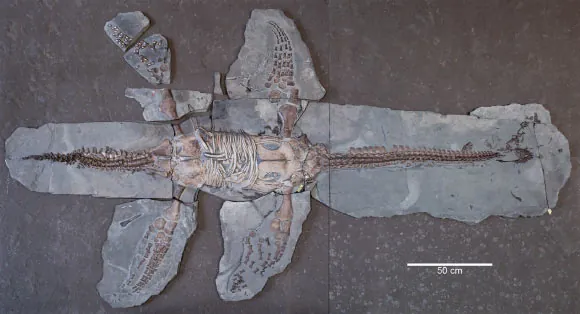
Exciting New Plesiosaur Discovery Unravels Mysteries of Early Jurassic Marine Life!
2025-03-31
Author: Li
In a groundbreaking discovery, paleontologists in Germany have uncovered a stunningly preserved skeleton of an Early Jurassic plesiosauroid species, dubbed Plesiopterys wildi. This remarkable find sheds light on the diversity and regional specialization of plesiosaurs, ancient marine reptiles that ruled the seas during the Jurassic period.
The Early Jurassic Era
The Early Jurassic era, around 180 million years ago, was marked by the ongoing break-up of the supercontinent Pangea, creating varying climatic conditions that alternated between warm greenhouse climates and icy environments. This contributes significantly to the diversification of marine reptiles, including the enigmatic Plesiosauria.
Discovery Details
Researchers from Lund University, led by paleontologist Miguel Marx, discovered the 3-meter-long skeleton in the Posidonienschiefer Formation near Holzmaden, southern Germany. They emphasize that Plesiopterys wildi is distinct within the overall marine fossil record, which is predominantly filled with ichthyosaurs and marine crocodiles from the same formation. The specimen, known as MH 7, stands as one of the most complete articulated plesiosaur skeletons ever found in the region.
Unique Taxon
"This new discovery offers a rare lens into the biodiversity of these long-necked marine reptiles," stated Dr. Marx. The specimen represents a subadult individual, refining the known characteristics of this species and reinforcing its classification as a unique taxon.
Evolutionary Significance
Phylogenetic analysis places Plesiopterys wildi as an early-diverging plesiosauroid closely related to Franconiasaurus brevispinus. This finding suggests a gradual evolutionary transition toward later, more derived cryptoclidids from the Late Jurassic period.
Paleobiogeographical Insights
Moreover, the research indicates that various plesiosaur species may have exhibited regional distinctions within the epicontinental seas of Early Jurassic Europe. This highlights a significant aspect of paleobiogeographical segregation, suggesting that marine reptiles were evolving specialized adaptations and unique lineages much earlier than previously thought.
Expert Insights
Dr. Sven Sachs from the Naturkunde-Museum Bielefeld added, "This research has profound implications for understanding how marine reptiles adapted to environmental changes during the Jurassic period." The study’s results emphasize that distinct plesiosaur communities likely thrived in different regions of the European seas, providing a fascinating glimpse into the intricate tapestry of early marine life.
Publication
The study has been published in the peer-reviewed journal PeerJ, further contributing to our understanding of the evolution and diversity of these incredible creatures.
Conclusion
Stay tuned for more astonishing revelations from the world of paleontology! Who knows what other mysteries the sands of time will reveal?




 Brasil (PT)
Brasil (PT)
 Canada (EN)
Canada (EN)
 Chile (ES)
Chile (ES)
 Česko (CS)
Česko (CS)
 대한민국 (KO)
대한민국 (KO)
 España (ES)
España (ES)
 France (FR)
France (FR)
 Hong Kong (EN)
Hong Kong (EN)
 Italia (IT)
Italia (IT)
 日本 (JA)
日本 (JA)
 Magyarország (HU)
Magyarország (HU)
 Norge (NO)
Norge (NO)
 Polska (PL)
Polska (PL)
 Schweiz (DE)
Schweiz (DE)
 Singapore (EN)
Singapore (EN)
 Sverige (SV)
Sverige (SV)
 Suomi (FI)
Suomi (FI)
 Türkiye (TR)
Türkiye (TR)
 الإمارات العربية المتحدة (AR)
الإمارات العربية المتحدة (AR)